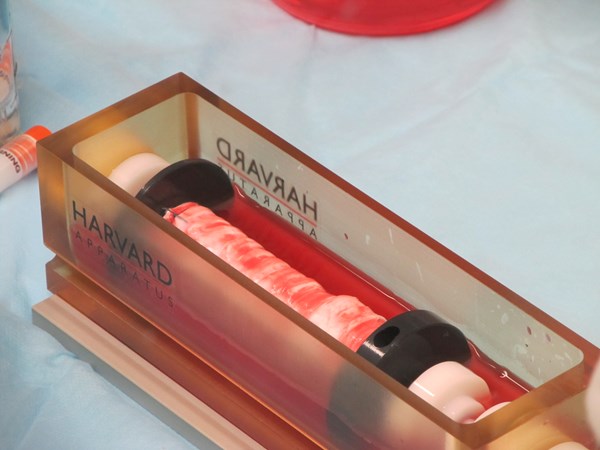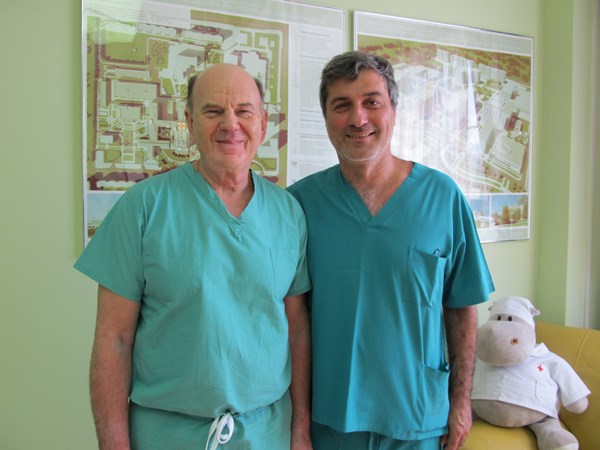HOLLISTON, Mass., June 26, 2012 (GLOBE NEWSWIRE) -- Harvard Bioscience, Inc. (Nasdaq:HBIO), a global developer, manufacturer, and marketer of a broad range of tools to advance life science research and regenerative medicine, announces that its "InBreath" bioreactors were used for the world's first and second successful laryngotracheal implants, using synthetic laryngotracheal scaffolds seeded with cells taken from the patients' bone marrow. The surgeries took place at Krasnodar Regional Hospital in Krasnodar, Russia on June 19th and June 21st. The recipients of the implants, Julia T. and Aleksander Z., are recovering well. The implants in the procedures were grown in bioreactors developed by the regenerative medicine device business of Harvard Bioscience.
The transplants, which required more than a half-year of preparation, were performed on the first two patients enrolled in an ongoing clinical trial at Krasnodar Regional Hospital. The Russian Ministry of Health has approved a clinical protocol for an unlimited number of patients in this trial, all of which will involve trachea procedures.
Each bioreactor was specifically adapted by Harvard Bioscience to the clinical requirements for each patient. Each bioreactor was loaded with a synthetic scaffold in the shape of the patient's original organ. The scaffolds were then seeded with the patient's own stem cells. Over the course of about two days, the bioreactor promoted proper cell seeding and development. Because the patients' own stem cells were used, their bodies have accepted the transplants without the use of immunosuppressive drugs.
A photo accompanying this release is available at http://www.globenewswire.com/newsroom/prs/?pkgid=13437
The procedures are the result of a global collaboration involving organizations in the US, Sweden, Russia, Germany, and Italy:
• The bioreactors were developed, manufactured and prepared by teams at Hugo Sachs Elektronik, a German subsidiary of Harvard Bioscience and at Harvard Bioscience, based in Massachusetts, U.S.A.
• The scaffolds were created by US-based Nanofiber Solutions.
• The principal transplant surgeon and main coordinator for both procedures was Dr. Paolo Macchiarini, Professor of Regenerative Surgery at Karolinska Institute in Stockholm.
• Dr. Macchiarini was assisted by a team of surgeons including Dr. Vladimir Porhanov, Chief Doctor of Krasnodar Regional Hospital and head of the Oncological and Thoracic Department of Kuban State Medical University; thoracic surgeons Dr. Igor Polyakov and Dr. Nikolay Naryzhnyi, of Krasnodar Regional Hospital; Dr. Anatoly Zavrazhnov, deputy chief of Krasnodar Regional Hospital; and Dr. Sergey Sitnick, anesthesiologist and head of Krasnodar Regional Hospital's intensive care unit.
• Dr. Alessandra Bianco at University of Rome, Tor Vergata, performed mechanical testing during scaffold development.
• The scaffold seeding process, which occurred at Krasnodar Regional Hospital, was overseen by a team comprising Dr. Philipp Jungebluth of Karolinska Institute; hematologists Dr. Irina Gilevich and Dr. Irina Pashkova of Krasnodar Regional Hospital; and Thomas Grosse of Hugo Sachs Elektronik.
• The patients were treated under a $4.8 million, 2.5-year Russian government Mega-Grant program intended to fund collaborations between Russian scientists and doctors and international leaders in their fields. The principal aim of the grant is to evaluate the molecular mechanisms and underlying pathways of tissue engineering and cell therapy for regenerating airways and lung tissue, and to carry out translational studies for the prevention and effective treatment of a wide range of diseases.
A photo accompanying this release is available at http://www.globenewswire.com/newsroom/prs/?pkgid=13438
Dr. Macchiarini commented, "I am very satisfied with the results of these transplantations, they are even better than those in my previous practice. Both patients are doing very, very well. Initial tests have already demonstrated the beginning of the epithelialization process on the transplanted tracheas."
Dr. Porhanov commented, "These surgeries are our first steps. We have identified at least four more candidates for these transplants and we hope to help them in the near future. We plan to establish an International Center of Excellence in regenerative medicine here in Krasnodar."
Ms. T., a 34-year-old mother of one child from St. Petersburg, was in an automobile accident and subsequently lapsed into a coma for an extended period, during which she sustained cicatricial stenosis of the trachea. This resulted in a significant tracheal occlusion and chronic infection of the trachea and lungs, along with a wide fissure in the neck. In order to speak, Ms. T. had to cover her neck fissure with her hand. Immediately after the surgery she was able to speak and breathe normally.
Mr. Z., a 28-year-old agricultural worker from Rostov-on-Don in the south of Russia, was in a car accident in June 2011. As a result, he sustained multiple fractures and was in a coma for two weeks, leading to tracheal stenosis. He could not speak and could hardly breathe. Mr. Z. was also able to speak and breathe normally following his surgery.
David Green, President of Harvard Bioscience, commented: "We are very pleased to have participated in additional medical procedures involving a regenerated trachea and to begin the first government-approved clinical trial for regenerated tracheal transplants. We congratulate Professor Macchiarini for achieving another world's first in regenerative medicine—the world's first laryngotracheal transplants. We are also very pleased to collaborate with Professor Porhanov and the Krasnodar Regional Hospital in Russia. Professor Porhanov is a very well-known thoracic surgeon who has led his hospital in performing over 80 heart transplants in the last two years. As a specialized cardio-thoracic transplant hospital, they are very well qualified to begin this clinical trial."
About Harvard Bioscience
Harvard Bioscience ("HBIO") is a global developer, manufacturer and marketer of a broad range of specialized products, primarily apparatus and scientific instruments, used to advance life science research and regenerative medicine. We sell our products to thousands of researchers in over 100 countries primarily through our 850 page catalog (and various other specialty catalogs), our website, through distributors, including GE Healthcare, Thermo Fisher Scientific and VWR, and via our field sales organization. HBIO has sales and manufacturing operations in the United States, the United Kingdom, Sweden, Germany and Spain with additional facilities in France and Canada. For more information, please visit www.harvardbioscience.com.
The Harvard Bioscience, Inc. logo is available at http://www.globenewswire.com/newsroom/prs/?pkgid=6426
Forward-looking Statements
The statements made in this press release that are not statements of historical fact are forward-looking statements within the meaning of Section 27A of the Securities Act of 1933 and Section 21E of the Securities Exchange Act of 1934. You can identify these forward-looking statements by our use of such words as "will," "guidance," "objectives," "optimistic," "potential," "future," "expect," "plans," "estimates," "continue," "drive," "strategy," "crucial," "potential," "potentially," "growth," "long-term," "projects," "projected," "produce," "intends," "believes," "goals," "sees," "seek," "develop," "possible," "new," "enabling," "emerging," "opportunity," "pursue" and similar expressions that do not relate to historical matters. Forward-looking statements in this press release may include, but are not limited to, statements or inferences about the HBIO's or management's beliefs or expectations, the field of regenerative medicine, opportunities or potential opportunities in the field of regenerative medicine, HBIO's business strategy, the positioning of HBIO for growth, the market demand and opportunity for HBIO's current products or products it is developing or intends to develop, and HBIO's plans, objectives and intentions that are not historical facts.
These statements involve known and unknown risks, uncertainties and other factors that may cause HBIO's actual results, performance or achievements to be materially different from any future results, performance or achievements expressed or implied by the forward-looking statements. Factors that may cause HBIO's actual results, performance or achievements to differ materially from those in the forward-looking statements include, but are not limited to, HBIO's failure to successfully expand its product offerings, introduce new products or commercialize new technologies, including in the field of regenerative medicine, decreased demand for the HBIO's products, including products in the field of regenerative medicine, due to changes in our customers' needs, our ability to obtain regulatory approvals, including FDA approval, for our products, including any products in the field of regenerative medicine, the current size or anticipated size of the regenerative medicine market, the existence and size of opportunities in the regenerative medicine market, our financial position, plus risk factors set forth under the heading "Item 1A. Risk Factors" in HBIO's Annual Report on Form 10-K for the fiscal year ended December 31, 2011 or described in HBIO's other public filings. HBIO's results may also be affected by factors of which HBIO is not currently aware. HBIO may not update these forward-looking statements, even though its situation may change in the future, unless it has obligations under the federal securities laws to update and disclose material developments related to previously disclosed information.
The photos are also available at Newscom, www.newscom.com, and via AP PhotoExpress.

